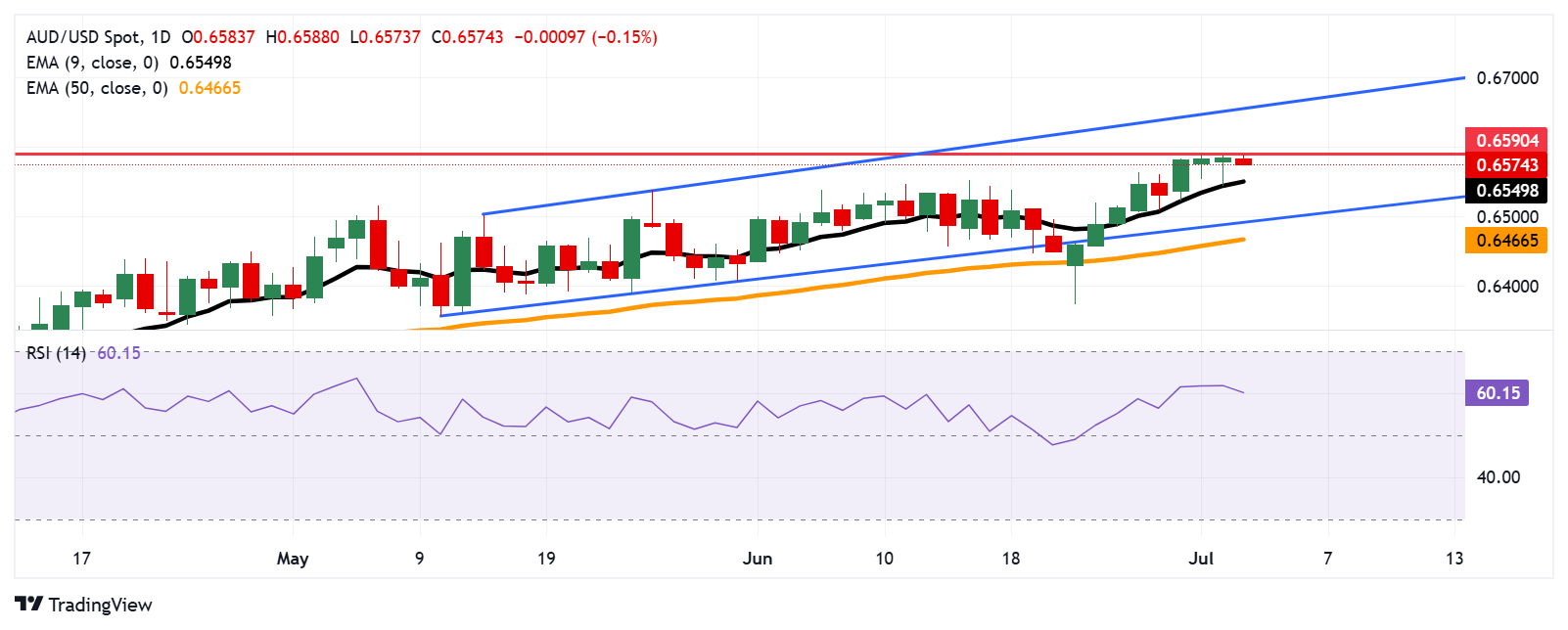- The Australian dollar is still under pressure after the commercial surplus was reduced to 2,238m month to month in May, compared to the 6,091m expected.
- The PMI of Caixin Services of China fell to 50.6 in June from 51.1 in May, breaking the expectations of the market of 51.0.
- Operators expect the US non -agricultural payroll to increase in 110,000 in June.
The Australian dollar (AUD) maintains losses against the US dollar (USD) on Thursday after the publication of key economic data. However, the fall of the Aud/USD torque could be contained as the US dollar (USD) loses ground amid increasing expectations that the Federal Reserve (Fed) will cut interest rates, driven by the disappointing National Employment Report of ADP.
The Australian Statistics Office (ABS) reported that the commercial surplus was reduced to 2,238m month to month in May, compared to the 6,091m expected and 4,859m (revised of 5,431m) in April. Meanwhile, exports fell 2.7% month by month from -1.7% (reviewed -2.4%) previously. Imports increased 3.8% month by month, compared to the previous increase of 1.6% (1.1% review).
The purchasing managers index (PMI) composed of S&P Global Australia rose to 51.6 in June from the previous reading of 50.5. Reading has marked a ninth consecutive month of growth and the fastest rate since March. Meanwhile, the PMI of Services rose to 51.8 from 50.6 previously, indicating the fastest expansion rate since May 2024.
In the nearby commercial partner of Australia, China, the Caixin Services PMI decreased to 50.6 in June from 51.1 in May, breaking the market forecast of 51.0.
The Australian dollar falls despite a weaker US dollar before labor data
- The dollar (DXY) index, which measures the value of the US dollar compared to six main currencies, is going back to recent profits and quoting around 96.70 at the time of writing. Operators are aware of labor market data, including non -agricultural payroll (NFP) of the US and average time gains, which will be published later in the day. In addition, the ISM services PMI and the US S&P PMI will also be observed on Thursday.
- The change of US employment from the US fell for the first time in more than two years in June. Private sector payrolls decreased by 33,000 in June after an increase reviewed down 29,000 in May. This figure was below the market consensus of 95,000.
- The main commercial officials of the US president, Donald Trump, were looking for tariff agreements by phases with the most committed countries while pressing to reach an agreement before the deadline of July 9, when Trump had promised to reimpose his most severe rates, according to Financial Times.
- The president of the FED, Jerome Powell, stressed on Tuesday that the US Central Bank will evaluate more data before starting a relief of monetary policy, but did not rule out a reduction of rates at the July meeting.
- The US Treasury Secretary, Besent, said he believes that the Federal Reserve (Fed) will cut interest rates before autumn, but will definitely cut the rates no later than September, according to Fox News.
- The USM manufacturing PMI of the United States advanced to 49.0 from 48.5 in May, exceeding the expectations of experts of 48.8. The readings indicated that economic activity in the US manufacturing sector improved in June. Meanwhile, US Jolts job offers increased to 7.76 million in May, compared to 7,395 million reported in April. This figure was above the market expectation of 7.3 million.
- The US Senate approved the “Great and Beautiful Budget Law” of President Trump, with a narrow margin of 51-50. The bill is now addressed to the US House of Representatives, where an adjusted vote is expected to face. Trump, who campaigned to eliminate the US federal deficit, is now ready to sign an expense bill that will add billions of dollars to the national debt during the next decade.
- The Purchase Managers Index (PMI) Manufacturing Caixin of China improved 50.4 in June from 48.3 in May, according to the latest data published on Tuesday. Reading exceeded 49.0 market forecast. It is important to note that any economic change in China could impact the AU, since both countries are nearby commercial partners.
- The Australian Statistics Office (ABS) showed that retail sales increased 0.2% month by month in May, compared to 0% flat in April (revised of -0.1%). The reading was below the market expectations of 0.4%. Meanwhile, construction permits increased 3.2%in May, compared to the previous decrease of 4.1%, but were below the expected increase of 4.8%.
- The purchasing managers index (PMI) of Australia Global S&P manufacturing fell to 50.6 in June from the previous 51.0. The production fell to its lowest reading since February due to adequate inventories of customers and weaker market conditions, according to data published on Tuesday.
The Australian dollar goes from maximum of eight months about 0.6600
The AUD/USD is quoted around 0.6570 on Thursday. The technical analysis of the daily chart indicates a persistent bullish as the torque moves up into the ascending channel pattern. The 14 -day relative force index (RSI) is positioned above the 50th mark, reinforcing the upward feeling. In addition, the torque is maintained above the nine -day exponential (EMA) mobile average, suggesting that the impulse of short -term prices is stronger.
On the positive side, the Aud/USD torque could try the maximum of eight months of 0.6590, which was marked on July 1. A successful rupture above this level could support the torque to test the upper limit of the upward channel around 0.6660.
The nine -day EMA at 0.6549 appears as the main support. A rupture below this level would weaken the impulse of short -term prices and exert the downward pressure on the AUD/USD torque to test the lower limit of the upward channel around 0.6490, aligned with the 50 -day EMA at 0.6466.
AUD/USD: Daily graphic

Australian dollar Price today
The lower table shows the percentage of change of the Australian dollar (AUD) compared to the main currencies today. Australian dollar was the weakest currency against the Swiss Franco.
| USD | EUR | GBP | JPY | CAD | Aud | NZD | CHF | |
|---|---|---|---|---|---|---|---|---|
| USD | -0.05% | -0.09% | -0.09% | -0.05% | 0.11% | 0.13% | 0.00% | |
| EUR | 0.05% | -0.05% | -0.02% | -0.01% | 0.16% | 0.14% | 0.09% | |
| GBP | 0.09% | 0.05% | 0.02% | 0.04% | 0.19% | 0.17% | -0.07% | |
| JPY | 0.09% | 0.02% | -0.02% | 0.03% | 0.20% | 0.14% | -0.03% | |
| CAD | 0.05% | 0.00% | -0.04% | -0.03% | 0.16% | 0.14% | 0.10% | |
| Aud | -0.11% | -0.16% | -0.19% | -0.20% | -0.16% | -0.18% | -0.26% | |
| NZD | -0.13% | -0.14% | -0.17% | -0.14% | -0.14% | 0.18% | -0.25% | |
| CHF | -0.01% | -0.09% | 0.07% | 0.03% | -0.10% | 0.26% | 0.25% |
The heat map shows the percentage changes of the main currencies. The base currency is selected from the left column, while the contribution currency is selected in the upper row. For example, if you choose the Australian dollar of the left column and move along the horizontal line to the US dollar, the percentage change shown in the box will represent the Aud (base)/USD (quotation).
Economic indicator
Commercial balance
This index published by the Australian Bureau of Statistics It shows the difference between exports and imports of Australian goods. Exports can offer a reflection of the growth of the Australian economy, while imports induction the state of domestic consumption. Thus, the trade balance offers an early reading of the net state of exports and the domestic market. A positive reading is seen as a bullish for the Australian dollar, while a negative figure is bassist for the currency.
Read more.
Last publication:
JU JUL 03, 2025 01:30
Frequency:
Monthly
Current:
2,238m
Dear:
5,091m
Previous:
5,413m
Fountain:
Australian Bureau of Statistics
Source: Fx Street
I am Joshua Winder, a senior-level journalist and editor at World Stock Market. I specialize in covering news related to the stock market and economic trends. With more than 8 years of experience in this field, I have become an expert in financial reporting.







